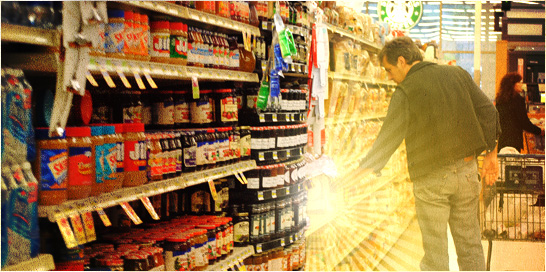
As the recent Tropicana packaging redesign fiasco shows, our perceptions of the products we choose are often made up of much more than the items themselves. But where do these brand perceptions come from, and how are they made? If designers are brand anthropologists, as Erin recently touched on, then consumers should be considered explorers, traversing shelf and window in search of that perfect bottle of tea or pair of shoes. And as in person-to-person interaction, in the branding world, first impressions are everything.
Marketers long ago realized the power of Saturday morning cartoons and used that time-slot to introduce countless children to a myriad of toys and snacks. Wide-eyed Children of the ’80s first learned about Fruit Wrinkles through claymation and the simple line: “Hi, my name is Roland, and these are Fruit Wrinkles.” It was fun, it was simple and it worked, and millions of globs of fruit flavored snacks graced the lunchboxes of a generation. Great brand strategists realize that at any given moment, someone, somewhere is experiencing their product for the first time, whether it’s in front of the TV, browsing the internet, or rolling their cart down the supermarket aisle. We call that process it Brand Discovery.
Brand discovery is sometimes used as an business-to-business term to describe an internal creative audit, but we think it has a much more powerful (and useful) meaning. Brand Discovery is strolling into the gas station to buy a Monster Energy Drink and noticing a can of Rockstar for the first time. It’s seeing a commercial for E-harmony while staring at your empty Match.com inbox. Or it’s glimpsing a Tom’s Shoes billboard around town and Googling the website when you get home. These and infinite more first contact experiences place the individual in the role of consumer-explorer, and being handed something on a platter is never as fulfilling as coming across it yourself.
Being handed something on a platter is never as fulfilling as coming across it yourself.
Sometimes entire marketing campaigns are based around the concept of Brand Discovery. Millions of drivers recently stuck in traffic spotted giant billboards with the words “WHO IS SALT”, only later to realize that they were seeing advertising for the latest Angelina Jolie thriller. Using mystery to reward consumer-explorers and create a buzz isn’t a new tactic (especially here in Hollywood), but it’s frequently turned to precisely because it works. At some level, all of us feel a sense of accomplishment when reach a summit and solve that mystery.
Established brands have also found a way to get involved. Generic products, once ridiculed, have been transforming en masse to more polished “Private Label” brands. Private Label sales hit a record high in 2009, and accounted for 90 percent of all gains in supermarkets. Target’s Archer Farm line of products are continuously being discovered by a regular clientele, and even Pharmacy giant Rite Aid is now getting in on the action. Eschewing Private Label offerings, some brands seek consumer-explorers through the use of variety. Remember when there were only two kinds of Cheerios? We don’t either.
With the constant barrage of new products hitting the marketplace each year, it’s becoming more and more difficult to connect with individual consumers. The tools we use to get the job done as brand strategists may change, but the experience stays the same. Exploring is exciting. Discovering is even better.
Photo illustration created using a photo by Anthony Albright, used under Creative Commons license.
You can leave a response, or trackback from your own site.